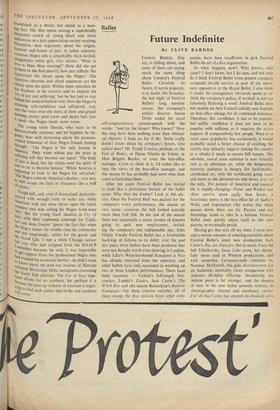Ballet
Future Indefinite
By CLIVE BARNES
LONDON BRIDGE, they say, is falling down, and some of them are saying much the same thing about London's Festival Ballet. Certainly its future, if not in jeopardy, is in doubt. On Saturday, the last night of Festival Ballet's long summer season, the company's artistic director Anton Dolin ended his usual self-congratulatory curtain-speech with the words: `And for the future? Who knows?' Now this may have been nothing more than whimsi- cal rhetoric. 1 hope so, for if Mr. Dolin really doesn't know about his company's future, who indeed does? Mr. Frank Cousins, perhaps, or the Earl of Holm, or Dame Ninette de Valois, or Miss Brigitte Bardot, or even the box-office manager. Come to think of it, I'd rather like to hear the views of the box-office manager, and this season he has probably had more time than usual to formula.te them.
After ten years Festival Ballet has started to look like a permanent feature of the ballet scene. Why then the doubts? Look at this pic- ture. Once the Festival Hall was packed for the company's every performance; this season on very many occasions the hall looked scarcely more than half full. At the end of the season there was apparently a minor exodus of dancers going .to seek new employment, includ- ing the company's one indisputable star, John Gilpin. Finally Festival Ballet has a formidable back-log of failures to its debit; over the past few years three ballets have been produced that were not thought worth even showing in London, while Lifar's Waterloo-bound 'Bonaparte a Nice has already retreated from the repertory, and other ballets have only succeeded in notching up two or three London performances. There have been successes — Lichine's full-length Nut- cracker, Lander's Etudes, Jack Carter's The Witch Boy and this season Balanchine's Bourree Fantasque—hut these creative twitches, all of them except the first revivals from other corn- panics, have been insufficient to give Festival Ballet the air of a live organisation.
So what happens now? Who knows, who cares? I don't know, but I do care, and not only do I think Festival Ballet (even present company accepted) should survive as part of the neces- sary opposition to the Royal Ballet, I also think i'. could. Its management obviously needs to re- think the company's policy, if re-think is not too fulsomely flattering a word. Festival Ballet does not receive an Arts Council subsidy and depends on box-office takings for its continued existence. Therefore, like cornflakes, it has to be popular, but unlike cornflakes it does not have to be popular with millions, as it requires the active support of comparatively few people. Were it to court mass popularity less assiduously, it would probably stand a better chance of catching the merely tiny minority support (taking the country as a whole) it needs to ensure full houses. The old-time, casual mass audience is now virtually tied to its television set, while the burgeoning minority audience is hungry for fashionably- certificated art, with the certificates going more and more to the adventurous and never, ever, to the tatty. The pattern of theatrical and musical life is rapidly changing—Pinter and Wesker can often survive more easily than farces, a Stravinsky opera is the box-office hit of Sadler's Wells, and impresarios who notice that those queues down there are for Picasso and not Munnings stand to rake in a fortune. Festival Ballet must quietly adjust itself to this new pattern, or eventually perish.
Having got that aria off my chest, I must now add a certain amount of sobering recitative about Festival Ballet's latest new production, Jack Carter's Pas des Fiancees. Set to music from the full Tchaikovsky Swan Lake score, but shame- fully never used in Western productions, and with somewhat Levasscur-style costumes by Norman McDowell, this gala divertissement for six ballerinas inevitably raises comparison with Ashton's Birthday 0 Bering. Structurally the Ashton piece is far stronger, and the absence of men in the new ballet severely restricts its choreographic interest and emotional variety. For all this Carter has created six classical solos
of considerable virtue, based affectionately, al- though not slavishly, on the academic dance vocabulary and showing a refreshingly unaffected inventiveness, It was well, if not consistently well enough, danced by its cast, among whom the languorous Olga Ferri and a sharp-accented newcomer Jill Bathurst were outstanding.
The Little Ballet Troupe from Bombay. who were one of the few interesting dance events of the Edinburgh Festival. appeared in London last week at the Scala Theatre. They performed two full-length ballets, in which the classical Indian dance has been largely coloured and influenced by folk dancing and the effect proves naively enchanting. i his distinguished company—it is in effect India's national ballet—has a child- like charm that never becomes childishly mawkish. Finally, let me remind you that this month the National Film Theatre is presenting a praiseworth•i season of ballet films. Good. bad and indescrit4ble. these films make up a re- markable collection, although nearly all of them are filmed ballet rather than the almost non- existent ballet film.















































 Previous page
Previous page